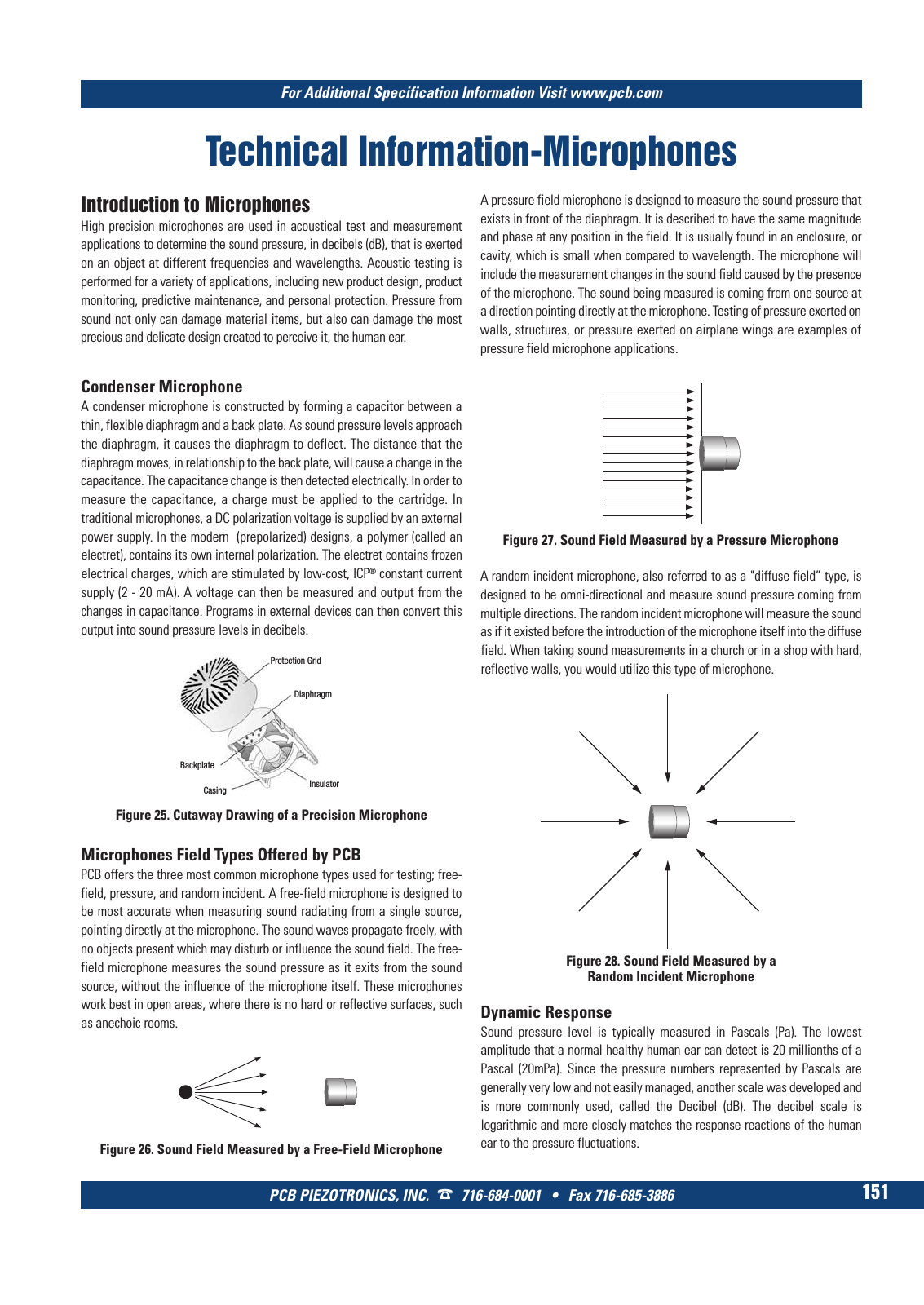PCB Test & Measurement Seite 153
Hinweis: Dies ist eine maschinenlesbare No-Flash Ansicht.Klicken Sie hier um zur Online-Version zu gelangen.
Inhalt
For Additional Specification Information Visit www pcb com PCB PIEZOTRONICS INC 716 684 0001 Fax 716 685 3886 151 Technical Information Microphones Introduction to Microphones High precision microphones are used in acoustical test and measurement applications to determine the sound pressure in decibels dB that is exerted on an object at different frequencies and wavelengths Acoustic testing is performed for a variety of applications including new product design product monitoring predictive maintenance and personal protection Pressure from sound not only can damage material items but also can damage the most precious and delicate design created to perceive it the human ear Condenser Microphone A condenser microphone is constructed by forming a capacitor between a thin flexible diaphragm and a back plate As sound pressure levels approach the diaphragm it causes the diaphragm to deflect The distance that the diaphragm moves in relationship to the back plate will cause a change in the capacitance The capacitance change is then detected electrically In order to measure the capacitance a charge must be applied to the cartridge In traditional microphones a DC polarization voltage is supplied by an external power supply In the modern prepolarized designs a polymer called an electret contains its own internal polarization The electret contains frozen electrical charges which are stimulated by low cost ICP constant current supply 2 20 mA A voltage can then be measured and output from the changes in capacitance Programs in external devices can then convert this output into sound pressure levels in decibels Figure 25 Cutaway Drawing of a Precision Microphone Protection Grid Diaphragm InsulatorCasing Backplate Microphones Field Types Offered by PCB PCB offers the three most common microphone types used for testing free field pressure and random incident A free field microphone is designed to be most accurate when measuring sound radiating from a single source pointing directly at the microphone The sound waves propagate freely with no objects present which may disturb or influence the sound field The free field microphone measures the sound pressure as it exits from the sound source without the influence of the microphone itself These microphones work best in open areas where there is no hard or reflective surfaces such as anechoic rooms A pressure field microphone is designed to measure the sound pressure that exists in front of the diaphragm It is described to have the same magnitude and phase at any position in the field It is usually found in an enclosure or cavity which is small when compared to wavelength The microphone will include the measurement changes in the sound field caused by the presence of the microphone The sound being measured is coming from one source at a direction pointing directly at the microphone Testing of pressure exerted on walls structures or pressure exerted on airplane wings are examples of pressure field microphone applications Figure 26 Sound Field Measured by a Free Field Microphone Figure 27 Sound Field Measured by a Pressure Microphone A random incident microphone also referred to as a diffuse field type is designed to be omni directional and measure sound pressure coming from multiple directions The random incident microphone will measure the sound as if it existed before the introduction of the microphone itself into the diffuse field When taking sound measurements in a church or in a shop with hard reflective walls you would utilize this type of microphone Figure 28 Sound Field Measured by a Random Incident Microphone Dynamic Response Sound pressure level is typically measured in Pascals Pa The lowest amplitude that a normal healthy human ear can detect is 20 millionths of a Pascal 20mPa Since the pressure numbers represented by Pascals are generally very low and not easily managed another scale was developed and is more commonly used called the Decibel dB The decibel scale is logarithmic and more closely matches the response reactions of the human ear to the pressure fluctuations 9 T Mcatalog 2011 Seite 125 166 SYN G500 21 04 11 18 04 Seite 157
